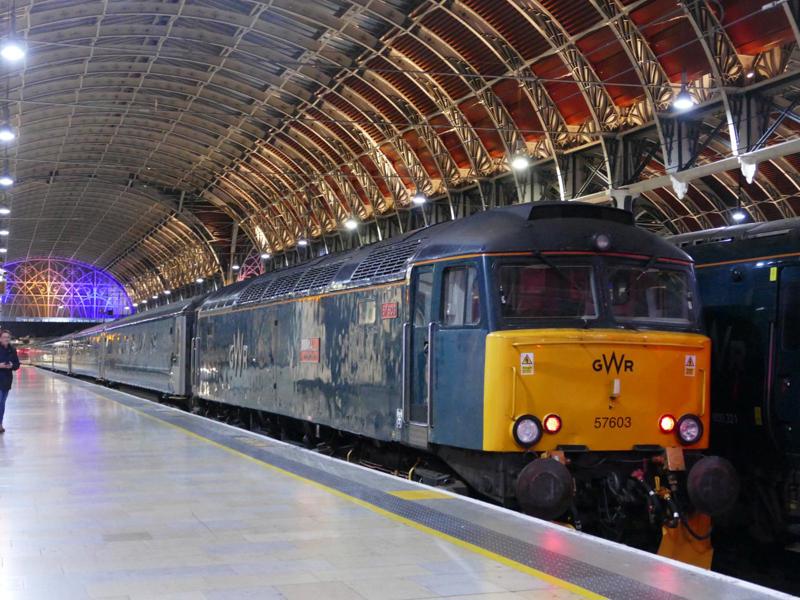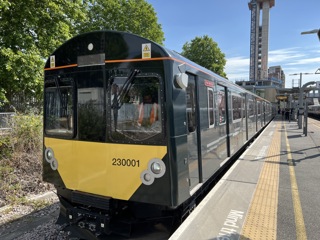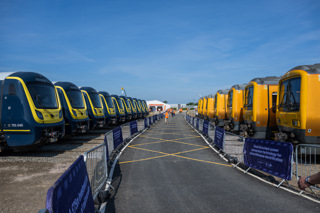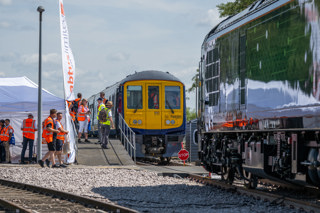In the first of a two-part feature, David Clough samples the night and day ‘Riviera’ services to and from the South West, starting with an overnight journey from the capital to Cornwall.
In this article:
In the first of a two-part feature, David Clough samples the night and day ‘Riviera’ services to and from the South West, starting with an overnight journey from the capital to Cornwall.
In this article:
- The 'Night Riviera' is one of two remaining UK sleeper trains, operating between London and Penzance.
- Europe's resurgence in sleeper trains is driven by environmental concerns and the cost-effectiveness compared to flights and hotels.
- The train provides comfortable, well-maintained sleeper compartments, though lacking some modern amenities like en suite facilities, and offers a unique travel experience.
At the start of the 1960s, there were more night services linking London with Glasgow and Edinburgh than ran during the day, owing to the length of the journey time.
Long-established service patterns remained, such as Euston to Oban and St Pancras to Galashiels. And sleeping cars were conveyed on overnight trains between Paddington and Birkenhead (Merseyside), as well as Euston-Liverpool.
However, throughout the 1970s, shorter daytime journey times and service rationalisation killed off most of this traffic.
Today, the ‘Night Riviera’ is one of only two sleeping car services that survive in the UK. The other is the multi-portion ‘Lowlander’ and ‘Highlander’ service which comprises the Caledonian Sleeper between London and Glasgow, Edinburgh, Fort William, Inverness and Aberdeen. Both services only survive because of subsidies from the UK and Scottish governments.
By contrast, Europe is seeing a minor resurgence in such trains, led by Austrian Federal Railways.
Part of the reason for the renaissance is a desire to ‘green’ the journey by not flying.
Another is that the length of journey makes the cost of the rail journey comparable with that of flight plus hotel.

There may also be the allure of overnight train travel as an experience.
Is there scope in Britain for more Sleeper services?
Arguably not. The existing ones are not viable commercially. The main traffic flows are between London and the Scottish cities in the Central Belt, and these passengers are already catered for. There does not appear to be any other corridor where there is sufficient patronage for a journey of at least four hours, that would justify an overnight train.
By contrast, the reintroduced Continental Sleepers cover significantly longer distances and journey times.
The English Riviera was a term coined by the pre-nationalisation Great Western Railway (the Old GWR, to distinguish it from today’s GWR), to market the coastal resorts in the West Country served by its trains. Using ‘Riviera’ in the names of its principal day and night services emphasised the connection.
The first sleeping cars on the Old GWR were introduced in December 1877 from Paddington to Plymouth, with just two coaches attached to the Night Mail.
Each coach was divided into three compartments - a seven-bed dormitory for males, a four-bed dormitory for females, and a central compartment containing two toilets.
The beds were positioned side-by-side, and the arrangement was likened at the time to recumbent cod laid out on a fishmonger’s slab.
These were replaced in 1881 by two new coaches which had six double-berth compartments and three toilets, with a side corridor. Superior to sleeping cars on other railways, these can be considered the template for the modern sleeping car.
Today’s Great Western Railway is a train operating company that operates (among others), trains between London Paddington and Penzance over the tracks of the Old GWR.
One of these services is the ‘Night Riviera’, which is subsidised by the Department for Transport.
The train conveys both single and twin berth sleeping cars and Standard Class-only seating. Reservations are compulsory. There is a buffet service that offers alcoholic and non-alcoholic drinks and snacks.
Running six nights per week (Saturday night excepted), it is formed of traction and rolling stock that is used just for these workings. Previously, except for the sleeping cars, locomotives and coaches that formed the ‘Night Riviera’ were also used on daytime operations.
The dedicated pool of resources for the ‘Night Riviera’ are set out in the table (page 62). All are allocated to Penzance Traction & Rolling Stock Maintenance Depot (generally referred to as Long Rock depot). At the London end of the line, Reading Traincare Depot services the locomotives and trainsets during the day.
The sleeping cars were built for the relaunch of the service in 1983. Eight have 12 Sleeper cabins and an attendant’s pantry, while three have 11 cabins plus one accessible cabin.
The RFM (Restaurant First Modular) and TSOD (Tourist Open Standard Disabled) vehicles date from 1975 and are among the oldest coaches in timetabled use, while the BSOs (Brake Standard Open) are the newest, entering service in 1986. All the coaches are of Mk 3 design and were refurbished at Wolverton works in 2018, when the saloons were fitted with a 2+2 seating configuration.
Long Rock is a Level 4 depot (on a scale where Level 5 is the highest, in tems of the maintenance work able to be carried out), and in some respects it can even perform Level 5 work.
In conjunction with Reading, locomotive maintenance is carried out on a ‘balanced B exam’ basis. This arrangement was first used in the UK when Foster Yeoman bought its General Motors (GM) Class 59s. Class 57s are re-engineered Class 47s, with refurbished GM engines and Brush Traction alternator sets and control gear from Class 56s.
The stock for the Down train leaves Reading depot at 2018 with a locomotive at each end. This is because there is no shunt release facility at Paddington.
The Class 57 that brings the train to Paddington will later detach at Reading, where the train (IC50) stops to pick up passengers and the detached locomotive returns to the depot.
The inbound empty stock is booked to be held at Royal Oak for 23 minutes and to arrive at Paddington at 2145. Sometimes this stop happens, sometimes it doesn’t. On the day of my journey, the stock rolled into Paddington hauled by 57603 four minutes early, having waited at Royal Oak for 20 minutes.
The time-honoured Platform 1 for ‘Night Riviera’ services is maintained. This is convenient for GWR’s First Class lounge, which is on that platform and is available for travellers booked in sleeping accommodation.
Boarding commences at 2230. On the dot, the train door interlocking is released, and I go to my booked compartment in coach E.
The fixtures and fittings have worn well, bearing in mind that these were last refreshed six years ago. The two-berth compartment is certainly compact, but no different to the Caledonian Sleeper Mk 5 equivalents, which are less than ten years old.
Unlike the Mk 5s, where some compartments have en suite facilities, none of the ‘Night Riviera’ cabins are so provided.
The compartment is very well laid out, even including a two-door wardrobe (a notch up on the Mk 5 equivalents), while there are mirrors at each end of the cabin.
A hinged lid covers the washbasin when the latter is not in use, and there are conveniently located shelves for each bunk.
A hand towel and small bar of soap are provided, although (for some reason) no hot water was available in either the cabin or toilet at the end of the coach. This was reported to the attendant. Each cabin does have individually controlled air-conditioning.
Cabin lighting is bright, and both upper and lower berths have separate three-pin 13A and USB power sockets and reading lights. Toilets at the end of the coach have a shaver point.
Although the bunks appear narrower than a standard single bed, they are not cramped. The mattresses are comfortable, and the upper bunk can be folded away to provide a cabin for single occupancy.
Sleeping car attendant Carol is quickly on the scene, complete with clipboard and wearing a smart uniform that includes GWR Green - a definite improvement on the drab attire of her BR colleagues during the 1970s and 1980s.
She wants to know if I want to use the shower facilities in the First Class lounge at Penzance on arrival there, if I have any onward connections in case the train is late, and my breakfast choices from the limited options and at what time?
Carol and her colleagues are all based at Penzance. She had left there at 1600 and travelled as a passenger to Paddington to work on IC50. Colleagues on the corresponding Up train (1A50), the 2145 from Penzance, start at 1900 and reverse this arrangement.
Sometimes, attendants work a double shift. On arrival at Paddington off the ‘Night Riviera’, they go to a hotel to sleep and return to work in the evening to cover 1C50.
Carol, who is responsible for two coaches, says the sleeping accommodation is virtually full - surprising for midweek in mid-April.
The Train Manager confirms that the train is well-loaded overall, noting that people view the train as a tourist attraction in its own right.
My train comprises four sleeping cars, a lounge/buffet car and two saloons, with 57602 at the head.
While any ticket booking facility can book a seat, station ticket offices (other than those of GWR) seemingly cannot reserve Sleeper cabins these days.
1C50 has a timing load of D350 tonnes, equal to a maximum of nine coaches for the heavy Mk 3 Sleeper stock. The maximum permitted speed is 75mph, which contrasts to the 80mph of BR days and today’s Caledonian Sleeper.
Departure is punctual at 2345, and 57603 is detached from the rear at Reading. Routeing is along the Berks & Hants line through Newbury to Taunton, the first stop after Reading.
By contrast, that evening’s Up ‘Night Riviera’, hauled by 57605, was sent over the route of the ‘great way round’ through Bristol, passed non-stop.
Thereafter, 1C50 calls at Exeter St Davids, Newton Abbot, Plymouth, and principal stations in Cornwall.
Engineering work can impose several alternative routes. These can be via Swindon to Castle Cary, via Bristol, or via Castle Cary to Yeovil, with reversal at Exeter St Davids. The normal schedule allows for such diversions by allocating a 74-minute stop at Taunton and 24 minutes at Exeter.
With 2,750hp of diesel power, 57602 makes light work of the train and is 15 minutes early into Taunton, gaining a further four minutes by the Exeter call.
Plymouth is reached punctually at 0537, where it is held for the booked 11 minutes, even though the stop is to set down passengers only.
Punctual progress through Cornwall ends at Bodmin Parkway, where over-time stops thereafter gradually make 1C50 six minutes late into Penzance at 0800. Dropping a few minutes on the last leg seems commonplace.
The ride quality of the Mk 3 Sleepers is much superior to their new Mk 5 equivalents. Cabin soundproofing is also good - the locomotive is inaudible, even though travelling in the third coach.
Something that is easy to overlook is the smoothness of the journey. There was no jerking as the train stopped, nor was there any snatching at restarting. This means I am unaware of station calls until Bodmin Parkway.
There is room for improvement in the quality of the breakfast, but a limiting factor appears to be that this is prepared in a small attendant’s pantry, rather than the on-train buffet.
The empty stock is booked to be propelled the short distance to Long Rock depot at 0921 under driver-only operation, but usually leaves well before this. On the day of my journey, it left at 0828.
The overall impression of the ‘Night Riviera’ was very positive. Operation is well planned and slick, with the facilities well presented, which help to engender a feeling of comfort and relaxation. The ‘Night Riviera’ can stake a claim to being one of the few great rail journeys left in Britain.
This is part one of a two parts on the Riviera sleeper service. Now read the second part.
For a full complete version of this article with extensive images and more data, Subscribe today and never miss an issue of RAIL. With a Print + Digital subscription, you’ll get each issue delivered to your door for FREE (UK only). Plus, enjoy an exclusive monthly e-newsletter from the Editor, rewards, discounts and prizes, AND full access to the latest and previous issues via the app.
Login to continue reading
Or register with RAIL to keep up-to-date with the latest news, insight and opinion.


















Login to comment
Comments
No comments have been made yet.